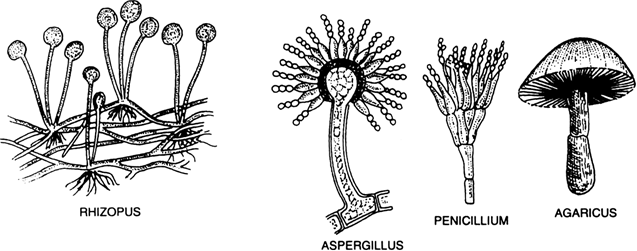What are the characteristics of fungi? Give examples.
Characteristics of Fungi :
(i) The organisms are saprophyte i.e., they use decaying organic material as food or may be parasite.

(ii) They have membrane bound nucleus. (iii) They have cell walls made of chitin.
Examples : Rhizopus, Yeast, Agaricus (mushrooms), Penicillium.
What are the characteristics of kingdom protista? Give examples.
Characteristics of Kingdom Protista:
(i) They are unicellular eukaryotic organism i.e., they have membrane bound nucleus and organelles.
(ii) Some of these organism use appendages such as hair like cilia or whip-like flagella for moving around.
(iii) Their mode of nutrition can be autotrophic or heterotrophic.
Examples:Unicellular algae (like Chlamydomonas, Chlorela), diatoms and protozoans like amoeba.
What are the three differences between plants and animals.
|
Plants |
Animals |
|
1. Most of the plants are stationary and do not move from one place to another. |
1. Most of the animals are mobile i.e., they can move from one place to another. |
|
2. They are autotrophic and make their own food as they have chlorophyll. |
2. They are heterotrophic and cannot make their own food. They do not have chlorophyll. |
|
3. Most of the plants continue growing throughout their life. The growth may be in length (Height) or producing spreading branches. |
3. Animals stop growing especially in length (Height) after attaining certain maturity. |
|
4. Plant cells have cell walls as outer most covering. |
4. Animal cell do not have cell walls. |
List the similarities between plants and animals.
The similarities between plants and animals are:
(i) Both plants and animals are made up of cells.
(ii) Both contain living substance protoplasm.
(iii) Certain life processes i.e., respiration, digestion, reproduction, assimilation etc. take place in both the groups in an identical manner.
(iv) Both show response to external stimuli.
(v) Growth is present in both the groups.
(vi) Both reproduce and pass on their hereditary characters to the offspring by the same mechanism.
